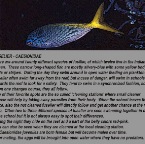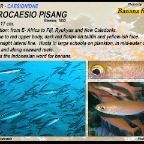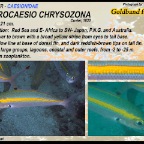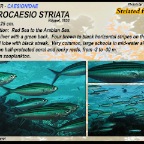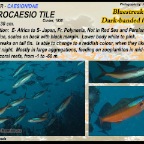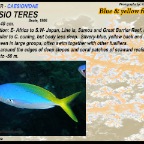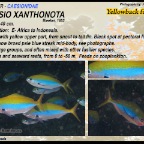Fusilier - Caesionidae
FUSELIER - CAESIONIDAE
There are around twenty different species of fusilier, of which twelve live in the Indian Ocean. These narrow long-shaped fish are mostly silvery-blue with some yellow body parts or stripes. During the day they swim around in open water feeding on plankton. Fuselier often swim far away from the reef, but incase of danger, will swim in schools towards the reef to look for a safety. They tend to swim in a synchronized fashion, so when one changes course, when in any danger, they all follow. One of their favorite spots are the so called ‘cleaning stations’ where small cleaner wrasse will help by taking away parasites from their body. When the school leaves the place, also the not cleaned fuselier will directly follow and get another chance at the next stop. Often two to three different species of fuselier are seen swimming together in one large school but it is not always easy to spot their differences. During the night they hide on the reef and a part of the belly colors red-pink. This can also be seen when they are cleaned at the local cleaning station. All Caesionidae juveniles are born female but will become males over time. After mating, the eggs will be brought into open water where they have no predators. Length: 18 cm.
Distribution: Endemic in the Red Sea.
Four brown to black horizontal stripes on the back, each tail lobe with black streak.
Very common, schools in mid-water along reef slopes on half-protected coral and
rocky reefs from 2 to -30 m. Length: 28 cm.
Distribution: Sri Lanka to Vanuatu, Ryukyus and New Caledonia.
Steep head profile, blue marks on head darker than background.
Yellow tailfin and back. Feeds on zooplankton, not shy. Length: 25 cm.
Distribution: from E- India and Sri Lanka to Philippines, Palau and Vanuatu.
Upper body silvery-green, lower body pinkish. Yellow horizontal stripe from eyes to
tail base. Dark tips on tail- and dorsal fin, black spot at base of pectoral fin.
In large groups, on steep slopes of deep lagunes, coastal and seaward reefs to -30 m. Length: 40 cm.
Distribution: E- Africa to S.W- Japan, Line Is, Samoa and Great Barrier Reef. Not in Red Sea.
Very similar to C. cuning, but body less deep. Silvery-blue, yellow back and tail.
Mostly seen in large groups, often swim together with other fusiliers.
Cruises around the edges of deep slopes and coral patches of seaward reefs.
From -5 to -50 m. Length: 17 cm.
Distribution: from E- Africa to Fiji, Ryukyus and New Caledonia.
Grey-blue to red upper body, dark red fintips on tailfin and yellow-ish face.
Has a straight lateral line. Hunts in large schools on plankton, in mid-water of deep
lagoons and along seaward reefs. Pisang is the Indonesian word for banana.


